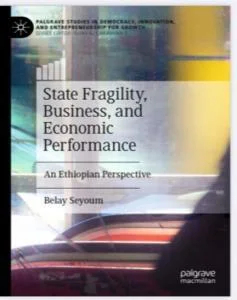Author: Professor Messay Kebede
Title: Ethiopian Modernization: Opportunities and Derailments. Oct. 2023
ETHIOPIAN MODERNIZATION: OPPORTUNITIES AND DERAILMENTS ( Book by Prof. Messay Kebede)
The book provides a strong set of arguments to support the view that Ethiopia’s modernization efforts were derailed by autocratic leaders who presided over extractive and exclusionary institutions. Authority and legitimacy came from centralized power structures that allowed for limited public participation. As is commonly said, absolute power corrupts absolutely, this approach to governance had adverse implications in all aspects of peoples’ lives ranging from poor educational infrastructure to inefficient and incapable bureaucracy. The author also states that this situation fostered a political opposition that embraced either a radical ideology based on Marxism-Leninism (Derg) or ethnonationalism (EPRDF). Modernization ended up being largely a failed experiment because Ethiopian governments were unable to reform the essence of the Ethiopian state through power sharing and genuine public participation in the political process.
It is a well-researched, well-written and informative book that traces the development of the Ethiopian state from the monarchic period to the present. It starts with a framework of modernization largely focusing on idealist and materialist approaches, addresses factors that contributed to the survival of the Ethiopian state over the years including the state’s Southern expansion, relations between church and state as well as land tenure system during the Imperial period. It also addresses student radicalization and overthrow of the Imperial regime as well as derailed modernization efforts under the different Ethiopian regimes. The book covers a broad area and a diverse set of issues that transpired in almost a century. In some areas, the book seems to have sacrificed depth for breadth of coverage. For example, it provides a cursory treatment of the cost of poor institutions, the difficult entrepreneurship climate as well as misguided education policy (including mother tongue education under EPRDF and present regime) that act as a barrier to the country’s efforts at modernization. Regardless, I congratulate the author for his significant contributions to Ethiopian studies, an area that has been largely ceded to foreign scholars and researchers.
My favorite part of the book is chapter 3 where the author analyses the inner workings and interconnections of three interacting forces: the monarchy, the church, and the nobility. The author provides an interesting explanation of the reliance of the church and nobility on Ethiopian Emperors who retained absolute authority over the state by dangling privileges that could be given or taken away at any moment in time. I believe the weakest part of the book relates to the coverage of the present situation in the country. I do not believe the book provides a sufficient analysis and review of the major forces that act as sources of instability in Ethiopia today: Ethnic federalism, the divisive and deficient constitution, external intervention, divided leadership and weak institutions as well as moral and ethical failures (absence of shared morality). Adequate treatment of these areas is critical since they constitute as major sources of Ethiopia’s fragility and failure.
I would like to take issue with some of the statements articulated in the book that appear to be controversial and may need further exploration and review. They are as follows:
- “Ethiopia’s pursuit of modernization was partly derailed by Menelik’s southern expansion as it allowed acquisition of human and natural resources to ward off potential enemies”. There is no theoretical or empirical basis to argue that territorial expansion acts as a limit to development. In many countries, such expansions are often accompanied by higher levels of innovation, initiative, and productivity. The lack of modernization may be attributed not to territorial expansion but to a domineering state that provides limited space for private initiative, investment, and entrepreneurship.
- “The Derg pursued the “colonial hegemony” of the Amhara over other ethnic groups”. The Amhara ruling elite (along with others) was largely decimated under the military regime and they were not in any position to exert much influence over the state. Moreover, it is not clear why Amhara domination over the Ethiopian state is given undue importance (in another chapter) since governance is a collective project managed by the country’s elite from different ethnic groups. This is also supported by your assertion that Ethiopian identity is not a tribe and that social mobility enhanced national integration into the power system. Even though many of the founding fathers largely came from the Amhara ethnic group (even in this case, many had mixed ethnic origins), integration of other groups into the ruling elite was achieved through various means including intermarriage, rewards for military service etc. that created an ethnically diverse ruling elite. Regime stability was largely achieved by creating a ruling class that transcended ethnic boundaries with opportunities for class mobility. For example, during the Imperial era, people from humble origins held important positions in government irrespective of their ethnic backgrounds. If dominance is measured in terms of the use Amharic as the national language or as a medium of instruction in schools, it was considered as an important means of uniting the country and creating social cohesion. Plural language policy was not (is not) a viable option as a way of creating one national identity. Additional research and exploration may be needed to clarify this issue since people mistakenly identify one ethnic group for the ills of the country. Moreover, the factionalized leadership of today tend to gain political capital by fueling real and imagined past grievances between ethnic and religious groups. They retain power by fostering a political environment of competition and conflict among ethnic groups (blaming an ethnic or religious group).
- You state “conquered and colonized peoples of the South”. I do not believe that Southern peoples consider themselves as conquered or colonized. They were rather incorporated into the empire. Some joined the ruling elite and others were not treated in any way that was different from that of the rest of the population. The author tends to ignore class alignment over ethnic divisions during most of the country’s history (till the advent of EPRDF). It is true that a large part of Southern land allocated to the Crown was granted to the nobility, favored gentry, civil servants, and the church. Almost a third of the total area was also granted to local leaders, In the North, Gult rights were not hereditary, and that land was similarly granted to members of the nobility, military and bureaucracy. There were landless peasants both in the North and South. The ruling class included the Southern elite and economic and political marginalization (of the rest) was not limited to the poor in the South but to poor people all over the country.
- The book states that “There is no good alternative to the preservation of ethnically demarcated states”. Ethnic politics is more about empowering the ethnic elite at the expense of people’s power. It undermines trust and makes it difficult to have productive social and economic relations between different ethnic groups, Territorial make-up based on ethnicity is divisive and nativist and violates the idea of one country. The pre-1994 territorial make up can be used for demarcating state boundaries with some adjustments. Relatively large and homogeneous states can be split up and merged with others to create diversity. I thank you for your contribution.

















Why meeting between the TPLF leaders and the federal government is considered controversial? What is controversial about it? Those who rush to make such absurd statements are those who were seen catching fire because these two sides were not talking. Please note I said ‘between the TPLF leaders and’ and I did not say between the leaders of Tigray. In practical terms there has not been an interruption of talking and dealing between the upright people of Tigray and the rest of the Ethiopian people for centuries. They have fallen together on glorious battle fields defending their gem they call Abyssinia/Ethiopia. That holy alliance was rudely interrupted when bigoted commies came on the scene in the late 1960’s and early 1970’s and tried to pull them apart. These miscreants partially succeeded in their evil scheme and more than 3 million citizens lost their Allah blessed lives. Do you think those demonic commies admitted their fallacies and apologized? No! Apology is not in their working protocol because in their sick scripture apology is a part of a backward system. They don’t accept apology from you once you are a designated ‘enemy of the people’. If you are a middle class by working hard, you are what they call a ‘petty bourgeois’ and a very dangerous enemy. Mao had gabbled up close to 25 million citizens who he perceived as middle class, petty bourgeois’ during his ‘Let Hundred Flowers Bloom’ deadly snare he devised to deceive and smoke out every middle class citizen. I our case, that country lost more than 500 thousand cream puff of the crop by commies’ deception and wrath during 1976 and 1978 alone. O commies, commies! Look what you have done to that gem of humanity. I hate to say this but I will say it no how. I wish you were not even born!!!!
wore! wore! wore!
Did you ever say anything to confront the criminals who are dropping bombs on Amharas using Dubai and Turk drone?